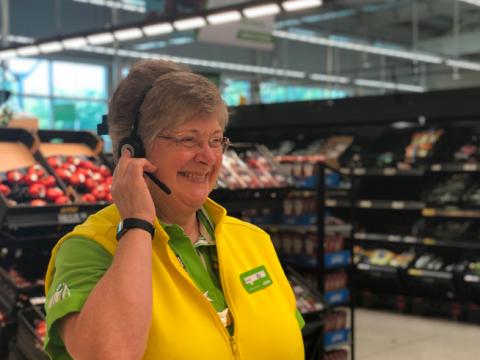Ways to improve customer service in retail
According to research by Salesforce, 67% of consumers and 74% of business buyers say they’d actually pay more for great customer experience.
The idea that the experience you deliver through your retail stores impacts customer satisfaction, average basket value and retention isn’t a new one. For as long as we’ve set up shop and peddled products to customers, it’s mattered that we’re able to do so quickly, efficiently, and with a smile on our faces. To not do so risks 39% of your customer base.
But the idea that more than half of your consumers — and three-quarters of the businesses buying in your products — will be willing to pay you more for a great experience? Viewed in this light, customer service becomes less about managing losses and more about growing your sales. Reviewing customer service from this perspective, you could actually leverage your ability to provide great experiences to improve the strength and profitability of your commercial models — and set yourself up to hit those ambitious stretch targets.
So how can you improve customer service in retail? Here are five tips for realistically and cost-effectively improving the customer experience, based on collective industry experience and knowledge of upcoming consumer trends.
Educate the customer when upselling
You may think your customers don’t like the whole upselling talk and prefer to be left alone when it comes to browsing items, but it’s not that clear-cut. In fact, 64% of customers are frustrated with the lack of guidance or in-store demos when it comes to purchasing products.
Let’s take a mobile phone store as an example. With so many different models and features now available on the market, choosing the right handset to suit their needs can be challenging for a customer. By listening to what the customer is after, your staff colleagues can recommend a make and model to match their demands.
The same approach can be used when upselling products or add-ons. Instead of pushing the sale and talking about the product in question, your staff colleagues could be educating the customer as to how it will benefit them and why they need it. You’re not only validating your recommendations; you’re empowering the customer by providing value and understanding. As a result, shoppers will be more likely to make a purchase through an employee who knows what they’re talking about.
Training your staff colleagues to educate the customer on the benefits of the product and why they should buy it will create a trusting bond between them. Such training can be rolled out company-wide and managed at a departmental level, making it quick and effective to implement at scale.
- Customer service communication: If your staff colleagues see a customer browsing the shelves with a puzzled look on their face, train them to approach the customer with open body language and offer to help. Advise that they talk to the customer in a language they understand (many customers won’t understand or care about jargon or terminology).
- Explain to the customer what the advantages of your product are, and what they can gain from it if they make a purchase. Don’t be pushy with the sale, but make sure your staff colleagues highlight the positives before the customer even has to ask.
Personalise your customer experience
Today’s consumers crave personalisation. We expect it from the emails we receive, the products we purchase, and yes, our retail experiences. But delivering a personalised experience isn’t just about matching the right products to the right customer. It’s about taking the time to find out what your customer’s preferences are and offer them a selection of similar products so they don’t feel pressured to buy a certain item. It means adjusting your service standards so that staff colleagues are a) available to help the customers as required, b) have the time to do so and c) can communicate with the customer one-on-one.
If a customer asks for a certain size, does your footwear assistant bring out the size below and above too, saving them extra waiting time and your staff from having to make repeated trips to the warehouse? Is there a relatively private place where the customer can try on the footwear and interact with the staff employee without feeling watched or pressured?
As with the first point, this is an internal education/training piece that can be overseen on a departmental level by floor/business unit managers, making it relatively practical and cost-effective to introduce across multiple stores or regions simultaneously.
- Customer service communication: Listen to each customer’s needs and recommend products to suit them. Be open, transparent, and communicative, respect the customer, and offer opinions if they’re unsure. Help the customer to feel valued and appreciated.
Implement innovative communication technology
There are many customer pain points that can impact a customer's experience. But by implementing innovative retail communication technology, you can improve your overall service and help keep the shopper’s loyalty and opinion on your brand. From a failure to locate a product, lengthy checkout queues, or lack of specialised staff, innovative communication technology can help amend these issues and improve customer service.
VoCoVo Call Points located around the store would allow customers to have a one-to-one conversation with employees through a speaker, satisfying their need to locate employees or a product and reducing the chance they will walk out empty-handed having not found what they are looking for.
The implementation of keypad technology can enable staff colleagues to quickly open tills to prevent or lessen queues, reducing the need for customers to wait and even take their business elsewhere.
Wireless retail communications solutions (like VoCoVo's wireless headsets) enable staff colleagues to talk with other users in any location, meaning they can draw from the combined expertise of the whole team to talk confidently about the products they’re selling and quickly answer or reassure the customer in question.
Technology implementation can be costly and time-consuming. Find a brand or supplier that supports proof of concept trials, enabling you to test and measure the effectiveness of the software in a select number of stores before committing to a full business rollout.
- Customer service communication: Train your staff colleagues to use the equipment productively and efficiently. Role-playing scenarios will improve the communication manner between employees and customers when talking through a Call Point system, for example.
Ask for feedback and learn from the results
Improving customer service is always going to be a work in progress, but knowing what to improve may seem difficult. Let your customers do the work for you and provide feedback forms about their shopping experience for them to complete in-store or online.
It’s quite common for retailers to have ‘rate us’ or ‘tell us about your experience’ text on the back of receipts, and for an extra incentive, offers customers further loyalty points or entry into a prize draw for doing so.
The feedback can be from surveys, forms, or questionnaires, and once you get it back you can understand some of your customers' experiences and what you can improve to increase your overall customer service rating.
- Customer service communication: If you provide the customer with a platform to voice their opinion, you’re giving them a chance to be heard and improve their future shopping experience. Make the customer aware that survey or feedback forms are available, and mention the reward they’d get for completing it. Most customers don’t take notice of receipts (especially the back of them), but may be keen to voice their good or bad experiences.
Spread the word — and smile!
This action may seem obvious but a lot of staff colleagues fail to do this, and it could be costing your business. As many as 42% of customers admit switching to competitors because of rude staff, so a smile can go a long way.
A calm and positive aura makes your staff colleagues much more approachable to customers with queries or other support needs. Train your staff colleagues so they are as comfortable as possible in customer-facing roles. Teach them to correctly introduce themselves to a customer with a smile and a greeting whilst retaining open and positive body language. After a customer has been served, say goodbye and encourage them to visit again.
- Customer service communication: Keep your staff happy with bonuses, rewards, social activities, and one-to-one meetings to discuss any issues they’re facing. A happy employee is a happy customer.
Are you providing exceptional customer service?
Customer expectations continue to change, and customer service needs to change with them. Think back fifteen or twenty years, when customer service was relegated to a desk at the back of a store. The queue was probably halfway across the shop floor, the customers were frustrated and the staff employee manning the desk would’ve felt much the same.
Today, customer service is an integral part of every staff assistant’s role and responsibilities. We’re doing business in an environment where customers have more choices than ever before and one wrong move could drive a switch to your competitor. Consider the impact of the above steps on your ability to deliver an experience your customers genuinely value, and they’ll reward you in kind with a willingness to pay more for your service — and your products.
Related

How VoCoVo will save you money
Team communications can help you to provide the kind of service that will keep your customers coming back time and time again. Discover why VoCoVo is a solid investment and how much you can save.

Top 4 ways VoCoVo wireless team communications can transform retail operations
Stores without walkie talkies depend upon colleagues looking for each other to answer customer questions, but VoCoVo allows staff to resolve queries on the spot.



